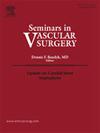老年人腹主动脉瘤破裂的结局和谁应该提供手术
IF 2.4
3区 医学
Q1 PERIPHERAL VASCULAR DISEASE
引用次数: 0
摘要
随着预期寿命的增加,腹主动脉瘤破裂(rAAA)的患病率对我们的医疗保健系统提出了重大挑战。衰老引起生物化学变化,包括细胞外基质的降解和血管平滑肌细胞的丧失,这增加了动脉瘤发展的倾向,并由于主动脉壁完整性受损而导致随后的破裂。老年rAAA患者的死亡率很高,从80%到90%不等。对于老年患者,开放和血管内修复都有很大的风险。虽然EVAR已被证明在这一人群中具有较低的围手术期死亡率,但老年患者面临着与年龄和虚弱相关的重大术后恢复挑战。在决定谁应该接受rAAA手术时,患者的选择是至关重要的。患者是否接受手术应考虑到虚弱和现有的合并症。针对患者的具体目标,考虑已有的合并症和功能状态,量身定制的方法对于改善老年rAAA患者的预后至关重要。本文章由计算机程序翻译,如有差异,请以英文原文为准。
Outcomes of ruptured abdominal aortic aneurysms in older adults and who should be offered surgery
As life expectancy increases, the prevalence of ruptured abdominal aortic aneurysms (rAAA) poses a significant challenge for our healthcare system. Aging induces biochemical changes, including degradation of the extracellular matrix and loss of vascular smooth muscle cells, which increase the propensity for the development of aneurysms and subsequent rupture due to compromised integrity of the aortic wall. The mortality rate for elderly patients presenting with rAAA is high, ranging from 80 to 90%. Both open and endovascular repair come with substantial risk for elderly patients. While EVAR has been shown to have lower perioperative mortality in this population, elderly patients face significant post-operative recovery challenges related to age and frailty. In determining who should be offered surgery for rAAA, patient selection is crucial. Frailty and existing comorbidities should be factored into whether or not patients are offered surgery. A tailored approach that is individualized to patient specific goals and accounts for pre-existing comorbidities and functional status is essential to improving outcomes for elderly patients presenting with rAAA.
求助全文
通过发布文献求助,成功后即可免费获取论文全文。
去求助
来源期刊
CiteScore
3.50
自引率
4.00%
发文量
54
审稿时长
50 days
期刊介绍:
Each issue of Seminars in Vascular Surgery examines the latest thinking on a particular clinical problem and features new diagnostic and operative techniques. The journal allows practitioners to expand their capabilities and to keep pace with the most rapidly evolving areas of surgery.

 求助内容:
求助内容: 应助结果提醒方式:
应助结果提醒方式:


